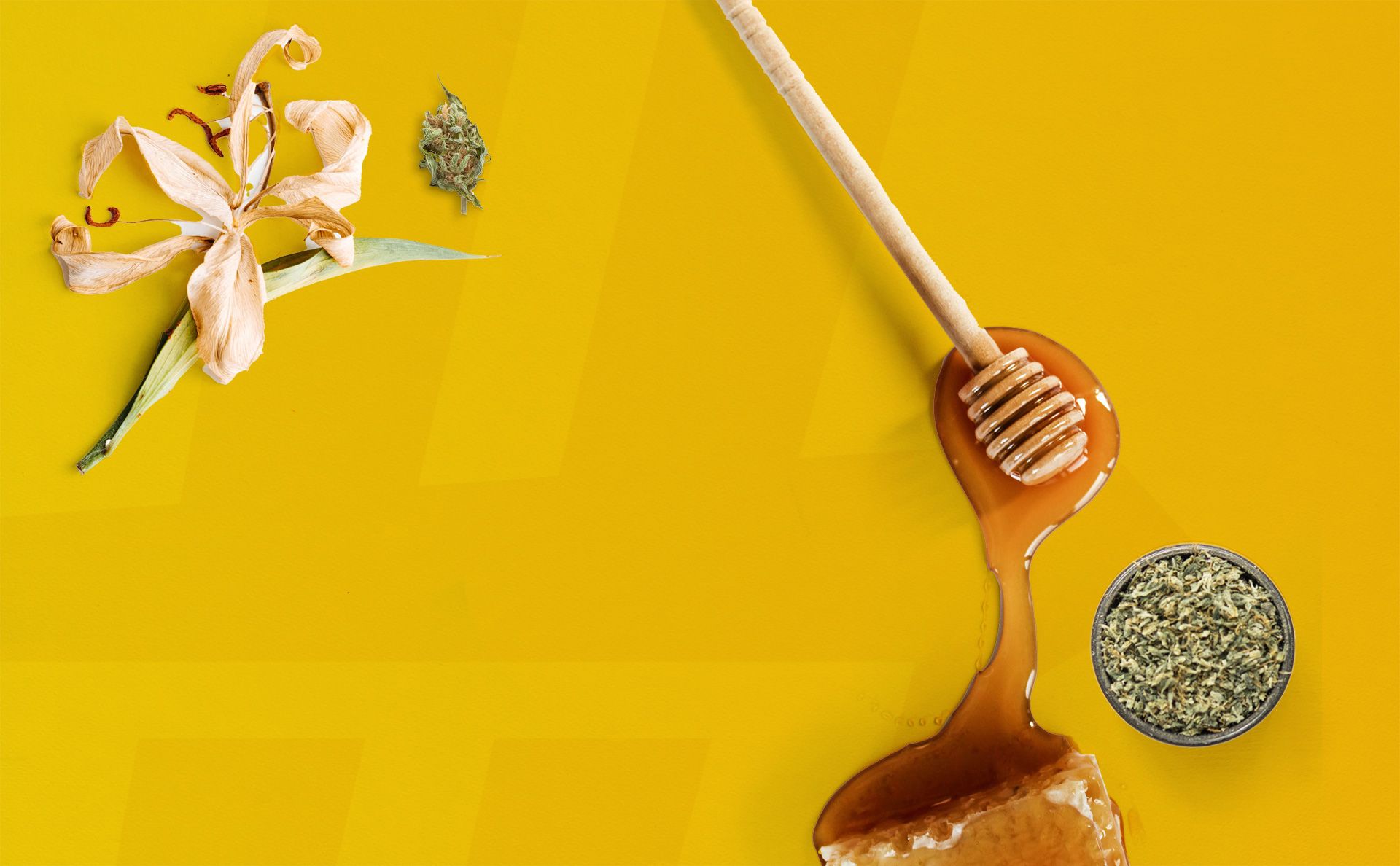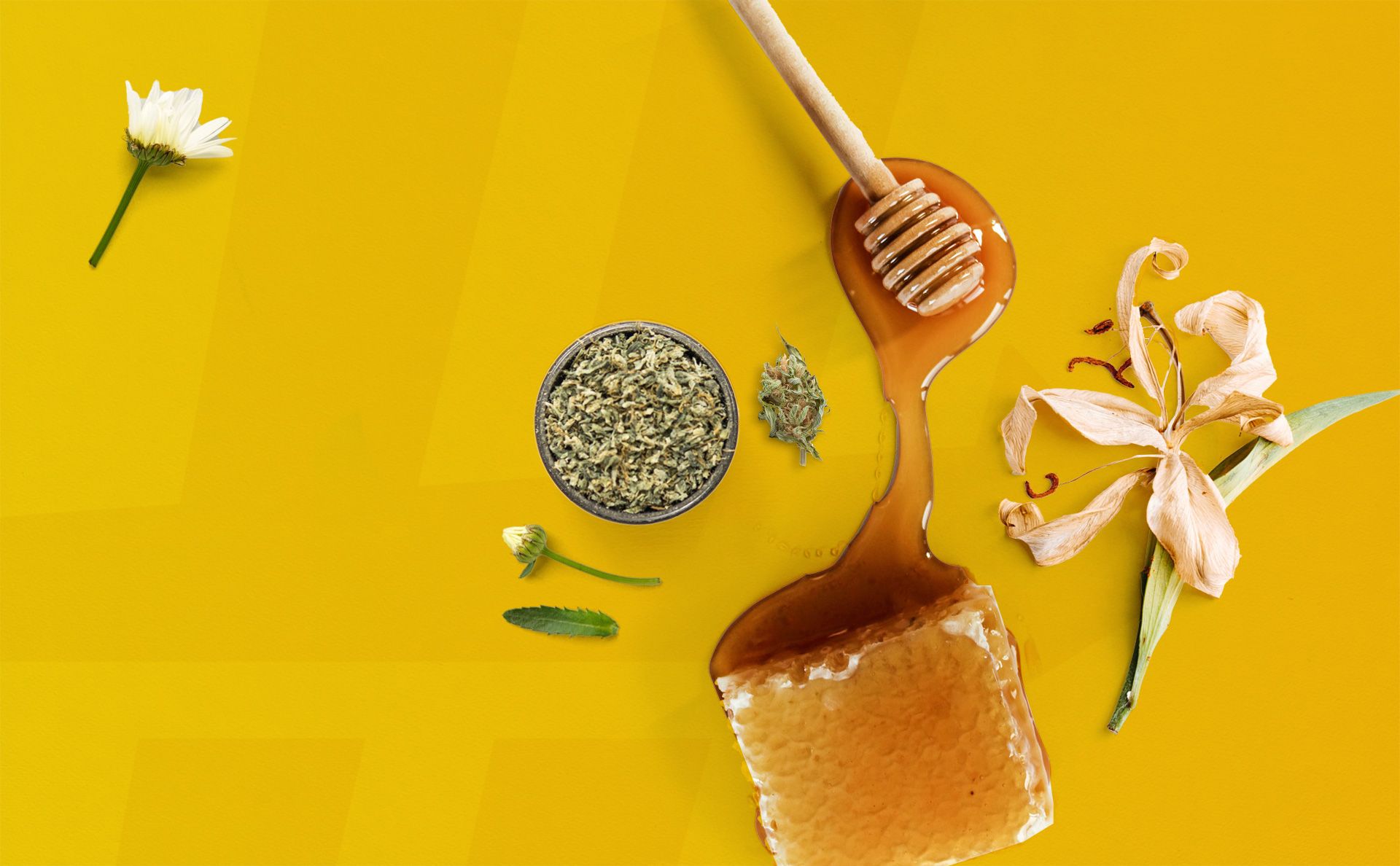Bisabolol
What is bisabolol? How does it make you feel, and what are its benefits? This chapter answers these questions and more.

In this chapter of our terpene guide, we cover bisabolol. This floral, sweet terpene has hints of earthy and woody flavors. Which other plants contain bisabolol? Are there any benefits of this terpene? You’ll learn all of the above in this chapter.
If you’re new to the wonderful world of terpenes, be sure to check out the intro to terpenes chapter earlier in this Guide.
What is Bisabolol?
Pronounced “biz-ahb-lowl,” bisabolol is a terpene found in abundance in plants like chamomile, guava, and cannabis. Its flowery aroma makes it popular in many skincare products. The first products containing replicated bisabolol were actually synthesized in the 1950s.
Chamomile is well-known for its relaxing aroma, with herbal notes and hints of vanilla and honey. In addition to chamomile, bisabolol is found in large quantities in plants like South African candela trees, South American candeia trees, and figworts.
Terpene Flavor and Aroma Profile: Bisabolol
Bisbolol’s unique flavor and aroma blend of herbaceous and earthy with notes and hints of vanilla and honey lend itself well to many popular cannabis cultivars. Some may also describe it as having a fruity, nutty aroma with hints of coconut. Many of your favorite dessert varieties contain noticeable amounts of bisabolol.


What the expert says...
Dr. Abraham Benavides
"Some of the most popular cultivars containing bisabolol are Bubble Gum, Birthday Cake, and Gelato. Bisabolol may differentiate between cultivars best, and is more often found in fiber-type or hemp cultivars."
Cultivars with the Terpene Bisabolol
In cannabis, bisabolol is typically thought of as a secondary terpene. This means you’ll find it in lower concentrations than myrcene, linalool, and limonene. This does not mean that this terpene isn’t noteworthy.
For example, an interesting research note is that the amount of bisabolol may contribute the most to differentiating between cultivars. It also appears to be more abundant in fiber-type cannabis, also known as CBDA and CBGA-dominant hemp varieties. Like linalool, bisabolol is also an alcohol-based terpene that is naturally made by enzymes in the cannabis plant.
There are still type I (THC-dominant) cultivars that are high in bisabolol. One cultivar in particular called Bubble Gum is actually bisabolol dominant. Bisabolol contributes to the depth of flavor in famously dessert-named cultivars like:
Bisabolol may also be commonly found in cannabis vape oil.
Does Bisabolol Get You High?
There is no evidence to date that bisabolol can get you high. However, a recent 2024 study pointed out that several terpenes can activate CB1 on their own with up to 10-50% the strength of THC, and even synergize with THC to increase the high.
But since bisabolol is poorly soluble in water, the researchers weren’t able to effectively test it in the study. Meaning, the answer is still unknown. We also don’t know if it interacts with the endocannabinoid system directly or indirectly in other ways.
Potential Benefits of Bisabolol
Bisabolol has been utilized in the form of chamomile as an active ingredient in many herbal remedies for centuries, thanks to its pain-relieving and anti-inflammatory properties. Bisabolol is also good for skin health.
Most of the studies on bisabolol are done on mice and in other preclinical settings. There are few clinical studies on it, but they are promising in regard to topical treatments for chronic mild to moderate atopic dermatitis in children. It may also be an effective ingredient in post-operative antiseptic and pain-relieving mouthwash.
In preclinical studies, bisabolol shows a lot of promise for anticancer, anti-inflammatory, and pain-relieving potential benefits. According to mice and test tube studies, bisabolol may:
- Inhibit melanoma and pancreatic cancer cells
- Trigger apoptosis (cell death), inhibit cell proliferation, and suppress certain cancer cell growth
- Moderate to significant evidence of pain relief%20pathways.)
- Reduce inflammation
- Induce wound healing
- Gastroprotective
- Neuroprotective
- Cardioprotective
- Nephroprotective (kidney protective)
- Antioxidant
- Antimicrobial and antiparasitic (against leishmaniasis)
Since bisabolol is poorly water-soluble, researchers are working on special bisabolol formulations to enhance its uptake in our bodies and potentially treat pancreatic cancer better.
What We Learned: Bisabolol
Bisabolol is just one of the many terpenes found in the cannabis plant. While there have been many anecdotes on bisabolol's effectiveness when used in plants like chamomile, more studies need to be conducted on terpenes in cannabis to determine their benefits. Here are the key takeaways from our bisabolol chapter:
- Bisabolol is found in the highest concentrations in the chamomile plant.
- Synthetic replication of bisabolol from German chamomile plants was used to first study bisabolol, dating back to the 1950s.
- Chamomile is well-known for its relaxing aroma, with herbal notes and hints of vanilla and honey, lending itself to popular dessert cultivars like Bubble Gum, Birthday Cake, and Gelato.
- Bisabolol has a multitude of potential benefits. These include pain-relieving, anti-inflammatory, and antiparasitic.
- As a topical product, bisabolol can increase the effectiveness of other ingredients in topicals and mouthwashes.
- Studies in lab mice indicate bisabolol may work to kill various types of cancer cells.
The future is bright for the wonderful world of terpenes. You can always count on HashDash to keep you educated and up-to-date on the science behind these dynamic compounds.
You completed our terpene guide! Great work! Now you have a better understanding of these fascinating and important compounds. You have only one more question to answer below to officially close out this Guide.
Citations
- Amora-Silva, B. F., Ribeiro, S. C., Vieira, C. L., Mendes, F. R., Vieira-Neto, A. E., Abdon, A. P. V., Costa, F. N., & Campos, A. R. (2019). Clinical efficacy of new α-bisabolol mouthwashes in postoperative complications of maxillofacial surgeries: A randhttps://doi.org/10.1007/s00784-018-2464-4
- Blesching, U. (2023). Bisabolol—Terpenes and Cannabinoid Research. Cannakeys.https://cannakeys.com/bisabolol-terpene-research/
- Booth, J. K., Yuen, M. M. S., Jancsik, S., Madilao, L. L., Page, J. E., & Bohlmann, J. (2020). Terpene Synthases and Terpene Variation in Cannabis sativa1[OPEN]. Plant Physiology, 184(1), 130–147.https://doi.org/10.1104/pp.20.00593
- Chacon, F. T., Raup-Konsavage, W. M., Vrana, K. E., & Kellogg, J. J. (2022). Secondary Terpenes in Cannabis sativa L.: Synthesis and Synergy. Biomedicines, 10(12), 3142.https://doi.org/10.3390/biomedicines10123142
- de Cássia da Silveira e Sá, R., Lima, T. C., da Nóbrega, F. R., de Brito, A. E. M., & de Sousa, D. P. (2017). Analgesic-Like Activity of Essential Oil Constituents: An Update. International Journal of Molecular Sciences, 18(12), 2392.https://doi.org/10.3390/ijms18122392
- Guo, W., Vrdoljak, G., Liao, V.-C., & Moezzi, B. (2021). Major Constituents of Cannabis Vape Oil Liquid, Vapor and Aerosol in California Vape Oil Cartridge Samples. Frontiers in Chemistry, 9.https://doi.org/10.3389/fchem.2021.694905
- Hanuš, L. O., & Hod, Y. (2020). Terpenes/Terpenoids in Cannabis: Are They Important? Medical Cannabis and Cannabinoids, 3(1), 25–60.https://doi.org/10.1159/000509733
- Javed, H., Meeran, M. F. N., Azimullah, S., Bader Eddin, L., Dwivedi, V. D., Jha, N. K., & Ojha, S. (2020). α-Bisabolol, a Dietary Bioactive Phytochemical Attenuates Dopaminergic Neurodegeneration through Modulation of Oxidative Stress, Neuroinflammation https://doi.org/10.3390/biom10101421
- Kano, M. T., Kokuryo, T., Baba, T., Yamazaki, K., Yamaguchi, J., Sunagawa, M., Ogura, A., Watanabe, N., Onoe, S., Miyata, K., Mizuno, T., Uehara, K., Igami, T., Yokoyama, Y., Ebata, T., & Nagino, M. (2023). Cyclodextrin Conjugated α-Bisabolol Suppresses Fhttps://doi.org/10.21873/anticanres.16245
- Licari, A., Ruffinazzi, G., DE Filippo, M., Castagnoli, R., Marseglia, A., Agostinis, F., Puviani, M., Milani, M., & Marseglia, G. L. (2017). A starch, glycyrretinic, zinc oxide and bisabolol based cream in the treatment of chronic mild-to-moderate atopichttps://doi.org/10.23736/S0026-4946.17.05015-0
- Liktor-Busa, E., Keresztes, A., LaVigne, J., Streicher, J. M., & Largent-Milnes, T. M. (2021). Analgesic Potential of Terpenes Derived from Cannabis sativa. Pharmacological Reviews, 73(4), 1269–1297.https://doi.org/10.1124/pharmrev.120.000046
- Nagoor Meeran, M. F., Azimullah, S., Laham, F., Tariq, S., Goyal, S. N., Adeghate, E., & Ojha, S. (2020). α-Bisabolol protects against β-adrenergic agonist-induced myocardial infarction in rats by attenuating inflammation, lysosomal dysfunction, NLRP3 infhttps://doi.org/10.1039/c9fo00530g
- Ramazani, E., Akaberi, M., Emami, S. A., & Tayarani-Najaran, Z. (2022). Pharmacological and biological effects of alpha-bisabolol: An updated review of the molecular mechanisms. Life Sciences, 304, 120728.https://doi.org/10.1016/j.lfs.2022.120728
- Raz, N., Eyal, A. M., Zeitouni, D. B., Hen-Shoval, D., Davidson, E. M., Danieli, A., Tauber, M., & Ben-Chaim, Y. (2023). Selected cannabis terpenes synergize with THC to produce increased CB1 receptor activation. Biochemical Pharmacology, 212, 115548.https://doi.org/10.1016/j.bcp.2023.115548
- Sampaio, T. L., Menezes, R. R. P. P. B. de, da Costa, M. F. B., Meneses, G. C., Arrieta, M. C. V., Chaves Filho, A. J. M., de Morais, G. B., Libório, A. B., Alves, R. S., Evangelista, J. S. A. M., & Martins, A. M. C. (2016). Nephroprotective effects of (-https://doi.org/10.1016/j.phymed.2016.11.008
- Sharma, M., Grewal, K., Jandrotia, R., Batish, D. R., Singh, H. P., & Kohli, R. K. (2022). Essential oils as anticancer agents: Potential role in malignancies, drug delivery mechanisms, and immune system enhancement. Biomedicine & Pharmacotherapy, 146, 11https://doi.org/10.1016/j.biopha.2021.112514
- Siracusa, L., Ruberto, G., & Cristino, L. (2023). Recent Research on Cannabis sativa L.: Phytochemistry, New Matrices, Cultivation Techniques, and Recent Updates on Its Brain-Related Effects (2018–2023). Molecules, 28(8), 3387.https://doi.org/10.3390/molecules28083387
- Wróblewska-Łuczka, P., Cabaj, J., Bargieł, J., & Łuszczki, J. J. (2023). Anticancer effect of terpenes: Focus on malignant melanoma. Pharmacological Reports, 75(5), 1115–1125.https://doi.org/10.1007/s43440-023-00512-1
Test your knowledge, track your progress and earn your badge.
What is a potential benefit of bisabolol?

Dr. Abraham Benavides
Dr. Abraham Benavides is an internationally-recognized cannabis research expert, experienced medical advisor, and full-tuition merit scholar of the George Washington University School of Medicine and Health Sciences. Dr. Abe enjoys helping patients as a writer, educator, and cannabis health coach at the GW Center for Integrative Medicine.